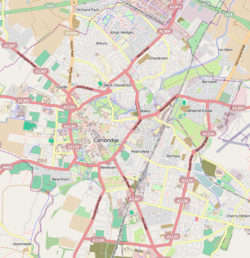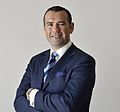| Hughes Hall | |
|---|---|
| University of Cambridge | |
 Margaret Wileman Building, Hughes Hall | |
 Arms:Quarterly 1st and 3rd Gules an owl proper Or.; 5th Gules a torch proper Sable; 2nd, 4th and 6th Ermine | |
| Scarf colours: light blue with three equally-spaced narrow stripes, the outer stripes of Cambridge blue and wider, the central stripe of white and narrower | |
| Location | Mortimer Road (map) |
| Full name | Hughes Hall in the University of Cambridge |
| Abbreviation | HH [1] |
| Motto | Disce ut Servias (Latin) |
| Motto in English | Learn in order to serve |
| Established | 1885 |
| Named after | Elizabeth Phillips Hughes |
| Previous names |
|
| Sister college | Linacre College, Oxford |
| President | Sir Laurie Bristow |
| Undergraduates | 201 (2022-23) |
| Postgraduates | 775 (2022-23) |
| Endowment | £8.2m (2023) [2] |
| Website | www |
| MCR | mcr |
| Boat club | hugheshallrowing |
| Map | |
Hughes Hall is a constituent college of the University of Cambridge in England. The majority of students are postgraduate, although nearly one-fifth of the student population comprises individuals aged 21 and above who are studying undergraduate degree courses. Hughes Hall was founded in the 19th century as the Cambridge Training College for Women with the purpose of providing a college dedicated to training women graduates for the teaching profession. Since then it has enlarged and expanded to support a community of students and researchers, both male and female, working in all the academic areas of the university.
Contents
- History
- College site
- Buildings
- Location
- Student life
- Societies and sports
- May Ball
- Notable members
- Principals/Presidents
- Fellows
- Alumni
- Honorary Fellows
- References
- Further reading
- External links
The college is housed in a number of 19th- and 20th-century buildings at a main site adjacent to Fenner's, the Cambridge University Cricket Club ground, and between the City Centre and the railway station.













